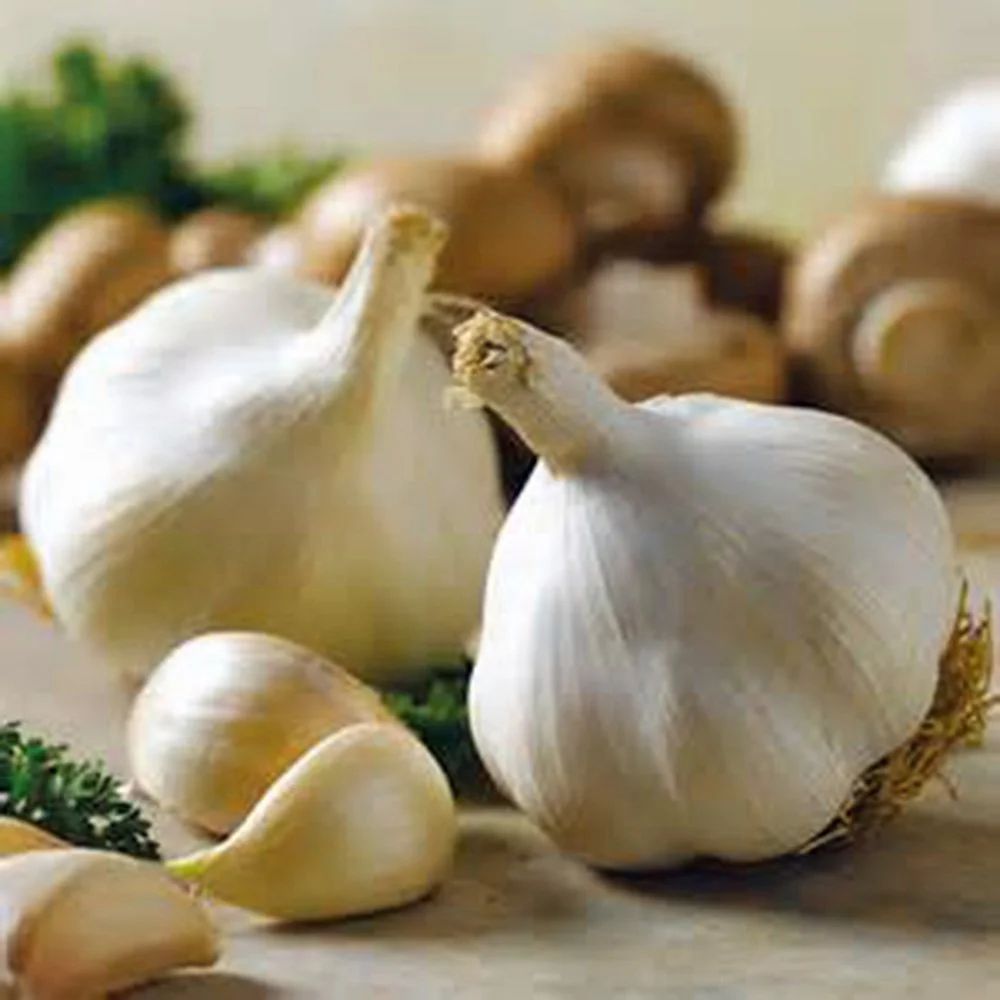Garlic
This vegetable originated in Central Asia and has been cultivated for thousands of years.
Planting Garlic in the Fall
Fall is prime time for planting garlic. Fall-planted garlic cloves will produce a new bulb by the next summer. Because garlic requires a cold period to properly produce, garlic cloves should be planted six to eight weeks before the ground is expected to freeze. This will give the cloves time to produce roots and to begin growing shoots before the ground freezes. Growth will resume come spring.
Garlic can be planted in the spring; however, if this is done, the cloves should be stored in a refrigerator for at least eight weeks prior to planting. This will ensure they have been properly chilled. While you can get good yields from spring-planted garlic, they tend to not yield as reliably as fall-planted garlic.
Garlic is a bulb and is made up of a collection of cloves. It has no seeds.To grow a crop, it is usually best to buy cloves from a garden center or catalog, but it's also possible to bring some home from a farmers market, choosing the largest and healthiest looking bulbs. Garlic sold in grocery stores is usually treated to prevent it from sprouting, so it's not a good choice for planting.
Don't divide bulbs into individual cloves until right before planting. Choose the largest cloves, making sure to discard cloves that are diseased, small, soft, or otherwise damaged to get the best yields.
Break up garlic bulbs. Plant about 1.5 inches deep in well-drained, fertile soil with full sun. Garlic does best in soils with an abundance of organic matter. Amend soils with compost or well-rotted organic matter. In addition to adding organic matter, apply 2 to 3 pounds of 10-10-10 fertilizer per 100 square feet before planting. Plant cloves 4 to 6 inches apart with 12 inches between rows.
Don't worry about which direction the cloves are laying in the row. Shoots grow up and roots grow down; they straighten themselves out.
Garlic is a poor competitor; weed control is critical to a successful garlic harvest. A 4- to 6-inch layer of weed-free straw or other organic mulch can be added to help control weeds. It will also help moderate soil temperatures.
If it gets too cold, less than 10 degrees Fahrenheit, you may wish to throw leaves or straw over the plants to protect them until it gets warmer.
Fertilize the plants at the beginning of March and again about mid-May.
A garden plot is not necessary for homegrown garlic. Cloves can be planted in pots or containers that are 4 to 6 inches deep. Use well-drained, loose potting soil and fertilize once a month. Leaves will emerge in several weeks and grow throughout the winter.
Varieties of Garlic
There are two main types of garlic: softneck and hardneck. Hardneck garlic produces a hard stalk called a scape, which is where the name hardneck comes from. It is easy to peel but it does not store well. On the other hand, softneck garlic stores well, making it popular with grocers, but it does not peel as easily. Softneck garlic also rarely produces a flower stalk, thus the softneck name.
Hardneck varieties to look for include Spanish Roja, Carpathian, Georgian Crystal, Music, Metechi, and Persian Star. Softneck varieties include Inchelium Red and Idaho Silverskin.
When growing a hardneck variety, the scape should be removed just after it uncoils. If the flower stalk is not removed, yield can be reduced by 25 percent or more.
Harvesting Garlic
In general, garlic grown in North America should be ready to harvest in late June or July, but knowing when to harvest garlic is both an art and a science.
Garlic should be harvested when half of the leaves have turned yellow. If the leaves are allowed to go entirely brown, the garlic will not have a tight head and won’t store well.
To test the crop, cut a garlic from the garden in half horizontally and examine the cross-section of the cloves to see how tightly packed they are. If the cloves are loose, then the garlic should be given more time to fill out.
After harvest, bulbs should be cured in a cool, dry, well-ventilated area for several weeks. Once garlic is cured, the stems and roots can be cut off and bulbs cleaned by removing the outermost skin, making sure not to expose the cloves. They should be stored in a cool, dry, dark place.
Culinary Use of Garlic
You don't have to wait until mid-summer to use garlic. The immature plants, the green garlic, can be used anytime. Use them as you would scallions in stir fry, or in pestos.
Freshly harvested garlic in summer will have a milder and sweeter taste than bulbs that have been stored.
Recipes
Garlic Scape Pesto
Scape Soup
Spicy Citrus Butter with Basil, Garlic, and Roasted Pecans





